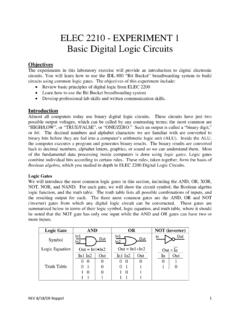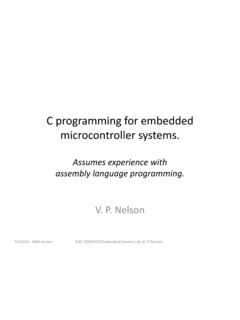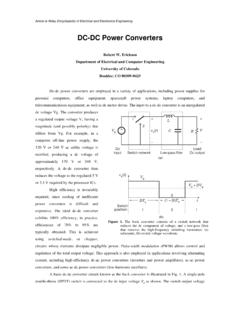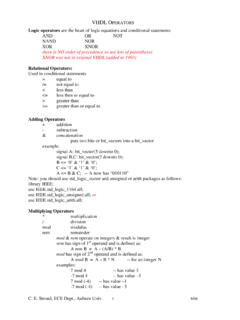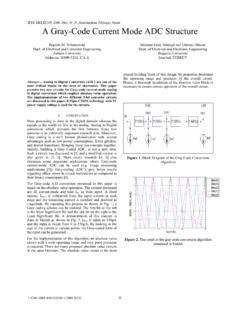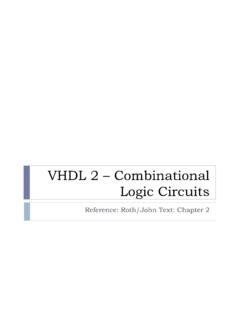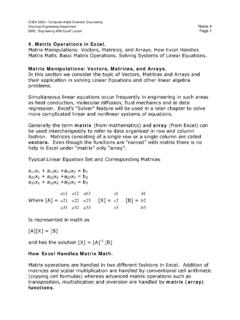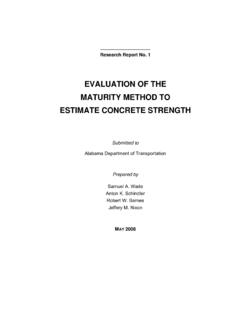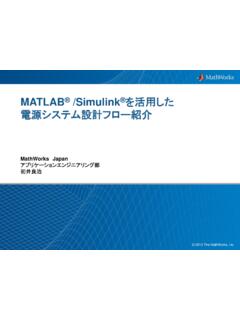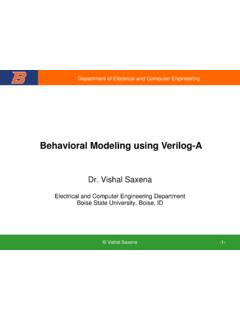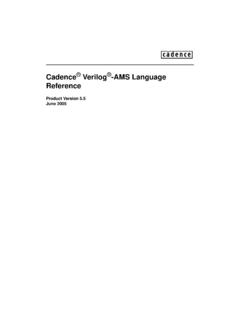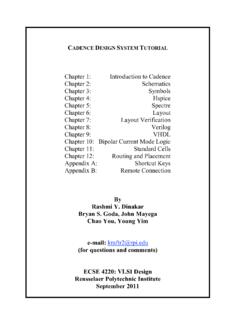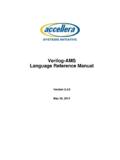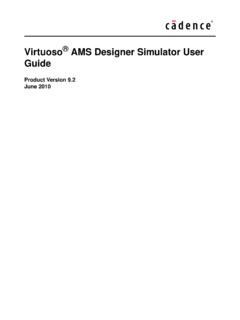Transcription of Verilog modeling* for synthesis of ASIC designs
1 Verilog modeling * for synthesis of ASIC designs * for native speakers of VHDLELEC 4200 Victor P. NelsonHardware Description Languages Verilog created in 1984 by Philip Moorbyof Gateway Design Automation (merged with cadence ) IEEE Standard 1364-1995/2001/2005 Based on the C language Verilog -AMS analog & mixed-signal extensions IEEE Std. 1800-2012 System Verilog Unified hardware design, spec, verification VHDL= VHSIC Hardware Description Language (VHSIC = Very High Speed Integrated Circuits) Developed by DOD from 1983 based on ADA language IEEE Standard 1076-1987/1993/2002/2008 VHDL-AMS supports analog & mixed-signal extensionsHDLs in Digital System Design Modeland documentdigital systems Behavioralmodel describes I/O responses & behavior of design Register Transfer Level (RTL) model data flow description at the register level Structuralmodel components and their interconnections (netlist)
2 Hierarchical designs Simulationto verify circuit/system design Synthesisof circuits from HDL models using components from a technology library output is primitive cell-level netlist(gates, flip flops, etc.) Verilog Modulesmodule small_block(a, b, c, o1, o2);input a, b, c;output o1, o2;wire s;assign o1 = s |c ;// OR operationassign s = a // AND operationassign o2 = s ^ c ;// XOR operationendmoduleI/O port direction declarationsLogic functionsThe moduleis the basic Verilog building blockModule name List of I/O signals (ports)Internal wire (net) declarations(Keywords in bold)Lexical conventions Whitespacesinclude space, tab, and newline Commentsuse same format as C and C++:// this is a one line comment to the end of line/* this is another single line comment *//* this is a multipleline comment */ Identifiers: any sequence of letters (a -z, A-Z), digits (0-9), $ (dollar sign) and _ (underscore).
3 The first character must be a letter or underscoreIdentifier_15, adder_register, AdderRegister Verilog is case sensitive(VHDL is case insensitive)Bob, BOB, bob // three differentidentifiers in Verilog Semicolonsare statement delimiters; Commasare list separatorsVerilog module structuremodulemodule_name(port list);port and net declarations (IO plus wires and regsfor internal nodes)input, output, inout- directions of ports in the listwire:internal net -combinational logic (needs a driver)reg: data storage element (holds a value acts as a variable )parameter:an identifier representing a constantfunctional descriptionendmoduleModule ports A port is a module input, output or bothmodule full_adder(ai, bi, cini, si, couti);input ai, bi, cini;//declare direction and typeoutput si, couti;//default type is wire Verilog 2001: Signal port direction and data type can be combinedmoduledff(d, clk, q, qbar); //port listinputd, clk;outputregq, qbar.
4 // direction and type Verilog 2001: Can include port direction and data type in the port list (ANSI C format)moduledff(inputd,inputclk,outputr egq, qbar);Data types Netsconnect components and are continuously assigned values wireis main net type (trialso used, and is identical) Variablesstore values between assignments regis main variable type Also integer, real, time variables Scalaris a single value (usually one bit) Vectoris a set of values of a given type reg[7:0] v1,v2; //8-bit vectors, MSB is highest bit # wire[1:4] v3; //4-bit vector, MSB is lowest bit # reg[31:0] memory [0:127]; //array of 128 32-bit values {v1,v2} // 16-bit vector: concatenate bits/vectors into larger vectorLogic values Logic values: 0, 1, x, zx = undefined statez = tri-state/floating/high impedance 0 1 x z0 0 x x01 x 1 x 1x xxxxz 0 1 x zwireMultiple drivers of one wire ABABS tate of the netAnalagousto VHDL std_logicvalues 0 1 X Z Numeric Constants Numbers/Vectors: (bit width) (radix)(digits) Verilog :VHDL:Note.
5 4 b1010 1010 or B 1010 4-bit binary value12 ha5cX 0a5c 12-bit hexadecimal value6 o71O 71 6-bit octal value8 d2552558-bit decimal value25525532-bit decimal value (default)16 bZx ZZZZ 16-bit floating value6 h5Ax 5 A 6-bit value,upper bits truncated10 h5510-bit value, zero fill left bits10 sh5510-bit signed-extended value-16 d5516-bit negative decimal (-55)Equating symbols to constants Use define to create globalconstants (across modules) define WIDTH 128 define GND 0module (input [WIDTH-1:0] dbus) .. Use parameterto create localconstants (within a module)module StateMachine( )parameter StateA= 3 b000; parameter StateB= 3 b001;..always @(posedgeclock)beginif (state == StateA) state <= StateB;//state transitionVerilog module examples // Structural model of a full addermodulefulladder(si, couti, ai, bi, cini);inputai, bi, cini;outputsi, couti;wired,e,f,g;xor(d, ai, bi);xor(si, d, cini);and(e, ai, bi);and(f, ai, cini);and(g, bi, cini);or(couti, e, f, g);endmodule// Dataflow model of a full addermodulefulladder(si, couti, ai, bi, cini);inputai, bi, cini;outputsi, couti;assignsi=ai^bi ^cini; // ^is the XOR operator in Verilogassigncouti=ai&bi |ai&cini|bi // &is the AND operator and |is ORendmodule// Behavioral model of a full addermodulefulladder(si, couti, ai, bi, cini);inputai, bi, cini;outputsi, couti.
6 Assign{couti,si} = ai+ bi + cini;endmoduleGateinstancesContinuousdri ving of anetOperators (in increasingorder of precedence*):||logical OR&&logical AND|bitwise OR~|bitwise NOR^bitwise XOR~^bitwise XNOR&bitwise AND~&bitwise NAND==logical equality!==logical inequality<less than<=less than or equalalso>greater than>=greater than or equal<<shift left>>shift right+addition-subtraction*multiply/divi de%modulus*Note that: A & B | C & D is equivalent to: (A & B) | (C & D)A * B + C * D is equivalent to:(A * B) + (C * D)Preferred forms -emphasizing precedence Unary operators:Examples:!logical negation~bitwise negation~4 b0101 is 4 b1010&reduction AND& 4 b1111 is 1 b1~& reduction NAND~& 4 b1111 is 1 b0|reduction OR| 4 b0000 is 1 b0~| reduction NOR~| 4 b0000 is 1 b1^reduction XOR^ 4 b0101 is 1 b0~^reduction XNOR~^4 b0101 is 1 b1reduction operator is applied to bits of a vector, returning a one-bit resultCombining statements// Wire declaration and subsequent signal assignmentwire a;assign a = b | (c // Equivalent to:wire a = b | (c Examples: 2-to-1 multiplexer// function modeled by its behavior moduleMUX2 (A,B,S,Z);inputA,B,S;//input portsoutputZ;//output portalways//evaluate block continuouslybeginif(S == 0) Z = A;//select input AelseZ = B.))
7 //select input Bendendmodule// function modeled as a logic expressionmoduleMUX2 (A,B,S,Z);inputA,B,S;//input portsoutputZ;//output portassign Z = (~S &A) |(S //continuous evaluationendmoduleA, B, Z couldalso be vectors(of equal # bits)Using conditional operator:assignZ = (S == 0) ?A :B;True/falseconditionif true : if falseMulti-bit signals (vectors)// Example: 2-to-1 MUX with 4-bit input/output vectorsmoduleMUX2 ARR(A,B,S,Z);input[3:0] A,B;// whitespace before & after array declarationinputS;output[3:0] Z;// little-endian form, MSB = bit 3 (left-most)reg[0:3] G;// big-endian form, MSB = bit 0 (left-most)alwaysbeginif(S == 0) G = A;//Select 4-bit A as value of GelseG = B;//Select 4-bit B as value of GendassignZ = G;endmoduleA,B,Z,G analagousto VHDL std_logic_vectorExamples: 4-to-1 multiplexer// function modeled by its behavior moduleMUX2 (A,B,C,D,S,Z1,Z2);inputA,B,C,D;//mux inputsinput[1:0] S;//mux select inputsoutputZ.)
8 //mux outputalways//evaluate block whenever there are changes in S,A,B,C,Dbegin //if-else formif(S == 2 b00) Z1 = A;//select input A for S=00else if(S == 2 b01) Z1 = B;//select input B for S=01else if(S == 2 b10) Z1= C;//select input C for S=10else if(S == 2 b11) Z1 = D;//select input D for S=11elseZ1 = x;//otherwise unknown outputend//assign statement using the conditional operator (in lieu of always block)assignZ2 = (S == 2 b00) ? A://select A for S=00(S == 2 b01) ? B://select B for S=01(S == 2 b10) ? C://select C for S=10(S == 2 b11) ? D://select D for S=11x;//otherwise default to xendmodule//equivalent case statement formcase(S)2 b00: Z1 = A;2 b01: Z1 = B;2 b10: Z1 = C;2 b11: Z1 = D;default: Z1 = x;endcaseSynthesis may insert latcheswhen defaults not structure of 4-to-1 MUX (using the previous 2-to -1 MUX)moduleMUX4 (A,B,c,d, S0,S1,Z);inputA,B,c,d,S0,S1;outputZ;wire z1,z2;MUX2 M1(A,B,S0, z1);//instance M1 of MUX2 MUX2 M2(c,d,S0,z2);//instance M2 of MUX2 MUX2 M3(.)
9 S(S1), .Z(Z), .A(z1),.B(z2)); //connect signal to port: .port(signal) endmoduleDefine MUX2 module in Verilog source before compiling MUX4 moduleABcdS1S0Zz1z2// more descriptive, less error-proneProcedural statements and blocks Aprocedurecan be an: always block, initialblock, function, task Define functionality in an algorithmic manner Insert multiple procedural statements between endkeywords Ablock contains one or more procedural statements initialblock Executes immediately at start of simulation Executes one time only Used primarily to initialize simulationvalues (rather than for synthesis ) alwaysblock Executes as an infinite loop Executes immediately at start of simulation Executes again whenever enabled Enablement can result from time delay, signal change, signal state, previous adder/multiplexer : generating a clockwireclk;initial//execute once at start of simulationbeginclk<= 0; //initial state of clkreset <= 0.
10 //initial state of reset line#10 reset <= 1;//delay until time 10, and set reset to 1#10 reset <= 0;//delay until time 20, and set reset back to 0endalways//execute as infinite loop, beginning at start of simulationbegin#10 clk<= ~clk; //suspend loop for 10 time units, toggle clk, and repeatendIf a block contains a single procedural statement, begin-end can be (seg7, hexval);input[2:0] hexval;output[6:0] seg7;reg[6:0] seg7;always@(hexval) begin //any change in hexvalinitiates executioncase(hexval)3'b000: seg7 = 7'b1000000; //03'b001: seg7 = 7'b1111001; // 13'b010: seg7 = 7'b0100100; // 23'b011: seg7 = 7'b0110000; // 33'b100: seg7 = 7'b0011001; // 43'b101: seg7 = 7'b0010010; // 53'b110: seg7 = 7'b0000010; // 63'b111: seg7 = 7'b1111000; // 7endcaseendendmoduleELEC 4200 Lab 2: Binary to Seven-Segment Display DriverEnabling a procedural block with a clock@ (posedgeCLK) wait for rising edge of CLK (0->1, 0->X, X->1)@ (negedgeCLK) wait for falling edge of CLK (1->0, 1->X, X->0)@ (CLK) wait for either edge of CLK//Example: simple rising-edge triggered flip-flop:always@ (posedgeCLK) //wait for rising CLK edgebeginQ <= D; //Q changes on rising edgeend//Example: falling-edge triggered flip-flop with sync preset and clock enable:always@ (negedgeCLK)beginif(PR == 1) Q <= 1;//synchronous setelse if (CE == 1) Q <= D.

